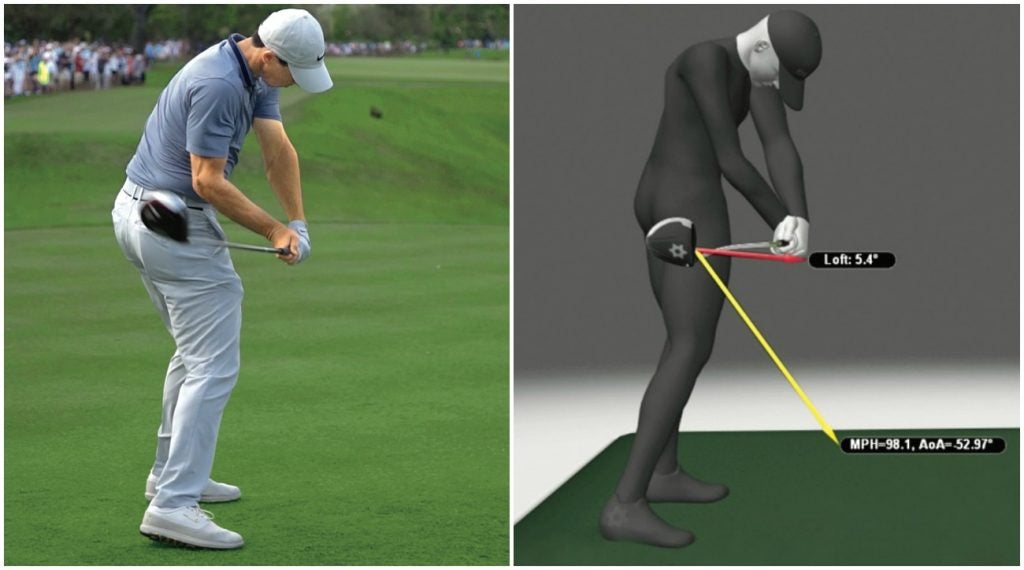 ‘They were wrong’: Curtis Strange takes issue with PGA rules decision
‘They were wrong’: Curtis Strange takes issue with PGA rules decision
TaylorMade’s 3D ‘Gears’ Technology reveals the secrets to Rory McIlroy’s powerful swing

The range at a PGA Tour event is a busy place. Among the crowd are caddies, coaches, agents, fitness trainers, mental gurus, Trackman reps, clubfitters, assistants, etc. At the center of it all is the modern-day Tour pro, who often couldn’t care less about the hordes gathered around them. Not many players command this kind of attention the way four-time major winner Rory McIlroy does, and for good reason: Rory’s swing is the kind that makes even his competitors stop, watch and take notice. “It’s impressive,” Jason Day says of Rory’s swing. “How do you get that kind of power out of that body?” McIlroy’s freewheeling golf motion has become his hallmark, and it’s produced some astonishing results over the years.
McIlroy, 30, has finished 1st, 11th, 1st, 2nd, 8th, 6th and 1st in Strokes Gained Tee-to-Green over the past seven seasons. To many, his swing is the game’s gold standard. You’ve seen McIlroy swing on TV, or maybe even in person. With the help of TaylorMade’s GEARS 3D, you can now learn from it in ways never before possible. The cutting-edge motion-capture technology lays bare three McIlroy moves that can take you from shortknocker to big-bomber in the blink of an eye. Here’s what the numbers prove.
He makes a huge turn
From address to the top of his backswing, Rory rotates his hips away from the target roughly 42 degrees and turns his shoulders approximately 116 degrees—two degrees more than John Daly’s 114-degree shoulder turn recorded by GOLF in 1992 (you know, when John Daly was the most feared driver in the game). The 75-degree difference between his shoulder and hip turn creates a massive amount of coil—in other words, potential energy that Rory can unleash into the ball at impact. This isn’t simply theory or conjecture: From the top to impact, Rory’s hips unwind more than 100 degrees (in the blink of an eye, no less). More impressive, his shoulders go from 114 degrees closed to
35 degrees open toward the target. All that rotational speed is what helps his clubhead reach upwards of 122 mph.

ADVERTISEMENT
He tilts back, then swings up
McIlroy uses a 9-degree TaylorMade M5 driver, but that doesn’t mean it’s the loft he sets up with. Rory positions the ball a hair farther back in his stance — just inside his left heel—than most Tour pros. Ordinarily, this would tend to deloft the face at address and promote a more downward attack angle. Not for Rory, who offsets his back ball position by angling his body in a unique way. The GEARS numbers tell the story: Rory sets up at address with his hands behind the ball and with his upper body tilted 13 degrees away from the target. Taking into account the upright angle of a driver—which closes the face subtly at address—Rory, on average, adds about one degree of loft just with his setup. The loft only continues to increase as a result of his dynamic motion. On the downswing, Rory slides his hips aggressively toward the target but keeps his head behind the ball. This turns his 13-degree body tilt away from the target at setup to a massive 34 degrees by the time he reaches impact. The result is an powerful, upward strike of 6 degrees. According to GEARS, the upward motion allows McIlroy to contact the ball about 0.1 inches higher on the clubface, which prevents any power-killing backspin. “The way Rory delivers the club into the ball creates ideal high-launch, lowspin impact conditions,” says Brian Bazzel, TaylorMade’s Vice President of Global Product Creation. “He’s maximizing all his launch conditions. It’s the reason he’s such an overachiever.” By the time Rory’s M5 reaches impact, he’s changed its static loft of 9 degrees to an effective loft of 17 degrees, all with his body motion! It’s the key to his booming drives.

He shifts first, turns second
Most golfers do three things in their swing: 1) They shift their weight forward and backward, 2) they move their weight up and down, and 3) they rotate. The key to unlocking maximum power is to ensure that these three actions occur in the right order. “When your sequence is off, your power is limited,” says GOLF Hall-of-Fame teacher Mike Adams. “You need to make sure that the peak forces are happening at the right time.” Once he reaches the top of his backswing, McIlroy shifts his weight toward the target. Then he rotates. This creates a chain reaction that pulls his upper body toward the ball, followed by his arms and then, finally, the club. This sequence of movements effectively transforms McIlroy’s arms and club into a whip. According to GEARS, Rory’s clubface going from about 90 degrees open halfway through the downswing to just over 87 degrees closed at the same time after the ball. Along the way, his club moves at 98 mph when the shaft is parallel to the ground on the downswing. A few feet later, it hits at 122 at impact. Milliseconds later, the speed drops to 86 mph. A combination of outrageously good technique, a ton of hard work and natural talent has made Rory McIlroy one of the most lethal drivers in history. Thanks to TaylorMade GEARS, you now know the numbers behind how did it. Our advice: Put them to use.
ADVERTISEMENT







